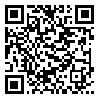Volume 22, Issue 1 (September 1998)
Research in Medicine 1998, 22(1): 31-37 |
Back to browse issues page
Download citation:
BibTeX | RIS | EndNote | Medlars | ProCite | Reference Manager | RefWorks
Send citation to:



BibTeX | RIS | EndNote | Medlars | ProCite | Reference Manager | RefWorks
Send citation to:
Rezvanian H, Sheikholeslam R, Azizi F. Diagnosis of Goiter by Primary Health Workers:Comparison of Two Methods. Research in Medicine 1998; 22 (1) :31-37
URL: http://pejouhesh.sbmu.ac.ir/article-1-2227-en.html
URL: http://pejouhesh.sbmu.ac.ir/article-1-2227-en.html
Isfahan University of Medical Sciences, Isfahan, Iran.
Abstract: (2207 Views)
Iodine deficiency disorders (IDD) have been a major health problem in Iran. In order to train primary health workers (Behvarz) the diagnosis of visible goiter, two methods were compared. I: With head and neck in normal position; II: With extended neck. Behvarzes in 29 rural health centers in Ghazvin were trained method I an d30 were trained method II. 1541 school children in Ghazvin and 1532 in Abjar, aged 8 to lo years were examined by Behvarz and 2 weeks later by an endocrinologist. The results showed sensitivity of 69.3 and 42.0 positive predictive value of 76.3 and 51.8% and efficiency of 610 and 58.7% with methods I and II, respectively. It is concluded that Bchvarzes do better diagnosis with method II and they should be trained with extended meck for epidemiological detection of goiter.
Type of Study: Original |
Subject:
Interdisciplinary (Educational Management, Educational research, Statistics, Medical education
Received: 2020/02/18 | Accepted: 2020/02/18 | Published: 2020/02/18
Received: 2020/02/18 | Accepted: 2020/02/18 | Published: 2020/02/18
| Rights and permissions | |
 |
This work is licensed under a Creative Commons Attribution-NonCommercial 4.0 International License. |






